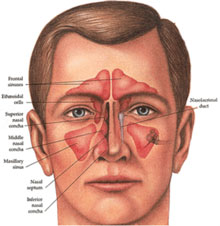CHRONIC RHINOSINUSITUS

The sinuses are air-filled bony structures located within the skull which are lined with a mucous membrane. The skull has four paired sinuses (frontal, ethmoid, maxillary, and sphenoid).
The frontal sinuses are just deep to the forehead. The ethmoids are located between the eyes. The maxillary sinuses are below the eyes and behind the cheekbones. Lastly, the sphenoid sinuses are located deep within the skull behind the orbits (eye sockets).
No one knows the exact function of the sinuses, but we do know that they can become inflamed or infected. The source of the infection can be viral, bacterial, fungal, or inflammatory.
There are many conditions which can increase one's risk of getting a sinus infection. These include: a recent viral upper respiratory tract infection (common cold), allergies, nasal polyps, deviated nasal septum, or autoimmune diseases that affect the sinuses. A sinus infection, referred to as rhinosinusitis, can be acute, subacute, or chronic. Acute infections have been present for less than four weeks, while subacute infections have persisted for 4—12 weeks. If a sinus infection lasts longer than 12 weeks, it is referred to as chronic sinusitis.
There are many different symptoms of rhinosinusitis. These include: nasal discharge or postnasal drip, nasal stuffiness, headache or facial pain, ear pain, head congestion, halitosis, and fatigue. In most cases, rhinosinusitis is a medical problem. It can be treated successfully with medications including antibiotics, decongestants, topical or oral steroids, and nasal rinses.
Occasionally, a sinus infection becomes chronic and does not respond to medications. These patients may benefit from endoscopic sinus surgery. Your physician will discuss whether this is appropriate for you.
